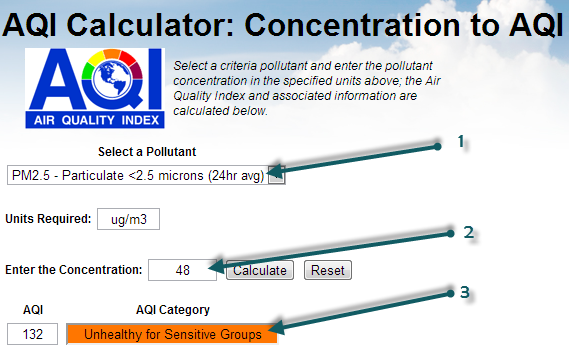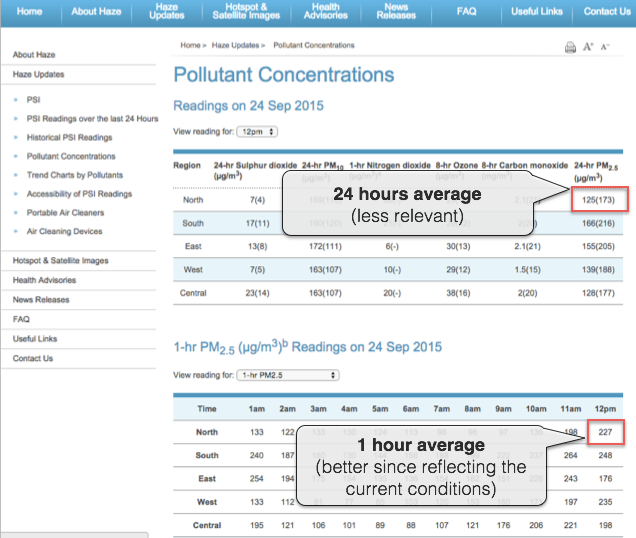In April 2014, the Singapore NEA has updated the PSI calculation to also include PM2.5. http://www.nea.gov.sg/anti-pollution-radiation-protection/air-pollution-control/psi
С неотдавнашния смог в Югоизточна Азия от Индонезия, засягащ Сингапур и сега Малайзия , получихме много въпроси защо има разлика между данните, които могат да бъдат прочетени от уебсайта на Сингапур NEA ( nea.gov.sg ) и проекта за Световния индекс на качеството на въздуха в Сингапур уеб страница .
Например, ето какво може да се прочете днес в сайта на NEA:

По някаква историческа причина Сингапур използва PSI ( Стандартен индекс на замърсителите ), за да оцени качеството на въздуха. В изображението по-горе номер 1 съответства на стойността на PM10, която се използва за оценка на PSI. Стойността 67(/59) може да се разчете като 67 μg/m3, което съответства на PSI от 59. PSI се оценява като максимума на индивидуалния PSI за всеки от замърсителите: PM 10 , SO 2 , NO 2 , O 3 (озон) и CO 2 .
PSI(Singapore-North) = max( PSIPM10-based, ... PSIO3-based )= max (59, ..., 77) = 77
Въпреки това, интересното е, че в същата тази таблица данните за PM2.5 също са предоставени в последната колона (вижте 3). Тези данни се предоставят само в μg/m3 (вижте 2) и няма преобразуване в нещо като PSI (т.е. преобразуване от масата на PM2,5 в индекс на замърсяване или качество). Това преобразуване обаче съществува и е определено от Агенцията за опазване на околната среда на САЩ . Най-лесният начин да направите преобразуването е да използвате онлайн калкулатора, достъпен на airnow.gov :

If you select the PM2.5 (1), then enter the mass concentration of 48 (2), can click on Calculate, you will obtain the AQI of 132 (3). So, based on the PM2.5 AQI conversion, the PSI that is used for Singapore could be extended (let's call it PSI++) to also take into account the PM2.5 information. In which case, the PSI++ would be the maximum of the regular PSI (based on PM10 only) and the PM2.5 AQI:
PSI++ = max( PSI, AQIPM.25 ) = max( 77, 132 ) = 132
This PSI++, that is commonly referred as AQI (or Air Quality Index), is what is being used on the the World Air Quality Index project, for all the cities (provided PM2.5 is available for the city). And this explains why the values are different between the NEA website and the World Air Quality Index project.
Moreover, when doing the convertion, make sure you use the 1-hour reading for the PM2.5 concentration rather than the 24-hours averaged value, as shown on the below image:

http://www.haze.gov.sg/haze-updates/pollutant-concentrations/type/PM25-1Hr
If you want to know more about PM10 vs PM2.5, and especially why PM10 is still used, please check the faq entry about why is PM2.5 often higher than PM10? Is PM10 still a relevant measure?
--
For more information about specific countries or continent, please refer to those articles: Thailand and Malysia - India - China - Hong Kong / Canada (Air Quality Health Index) - South America - Australia - Quebec and Montreal - Singapore - Poland - Indonesia .
For information about the 24 hours averaging used or Ozone and Particulate Matter (PM2.5), please refer to those two articles: Ground Ozone Index - PM2.5 Instant Cast
